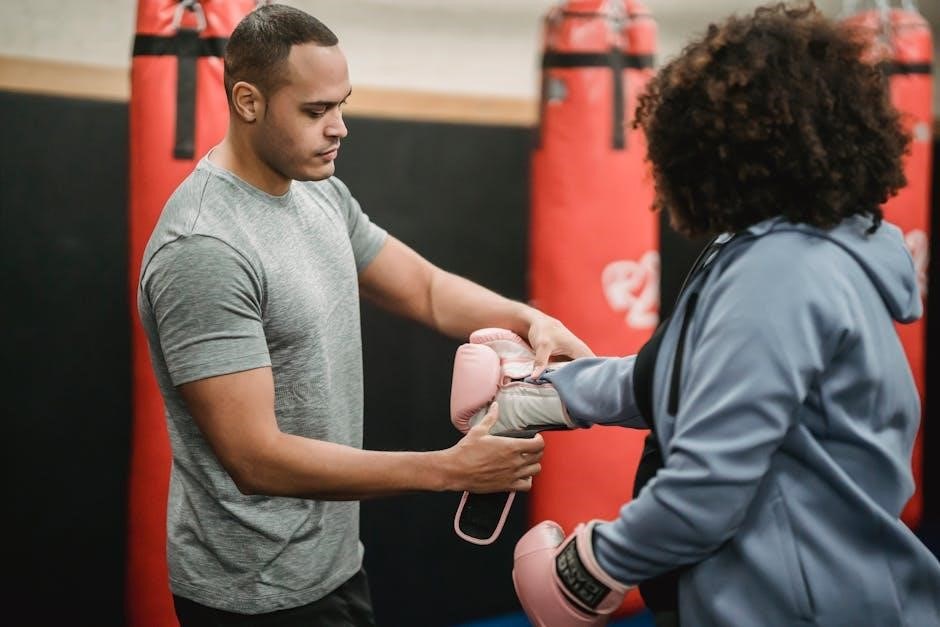Glove sizing ensures a perfect fit by measuring hand circumference and matching it to size charts, crucial for comfort and functionality in various activities․
1․1 Importance of Proper Fit
A proper fit is essential for comfort, functionality, and performance․ Ill-fitting gloves can cause discomfort, restrict movement, or even lead to blisters․ Whether for work, sports, or winter, gloves that are too tight may impede dexterity, while those too loose can reduce grip and safety․ Proper sizing ensures optimal protection, support, and flexibility, enhancing overall usability․ For instance, sports gloves require a snug fit for precise control, while winter gloves may need extra room for insulation․ Measuring hand circumference and matching it to a size chart guarantees the best fit․ Accurate sizing also extends the lifespan of gloves by preventing stretching or tearing․ Always prioritize proper fit to maximize comfort and performance across various activities and glove types․ Proper fit ensures gloves serve their intended purpose effectively․
1․2 Understanding Glove Size Charts
Glove size charts provide a standardized guide to determine the appropriate size based on hand measurements․ These charts typically vary by brand and glove type, with sizes ranging from extra-small to extra-large․ Charts often include measurements in inches or centimeters, corresponding to specific size categories․ For example, a hand circumference of 7-7․5 inches might fall under a small size, while 8-8․5 inches aligns with a medium․ Some charts use numeric sizing, such as sizes 6 to 12, which can differ between men’s and women’s gloves․ It’s crucial to refer to the specific chart provided by the manufacturer, as sizing can vary․ Understanding these charts helps consumers select gloves that offer the best fit, ensuring comfort and functionality․ Always consult the chart provided by the glove brand to ensure accuracy and avoid sizing mismatches․

How to Measure Your Hand for Gloves
To measure your hand for gloves, use a flexible tape measure around the widest part of your palm, excluding the thumb, ensuring an accurate glove size fit․
2․1 Tools Needed for Measurement
To accurately measure your hand for gloves, you will need a flexible fabric tape measure․ This tool allows you to wrap it snugly around your palm for precise circumference measurements․ If a tape measure isn’t available, alternatives like a string, strip of paper, or even dental floss can be used․ Simply wrap the material around your palm, mark the overlap point, and measure its length with a ruler․ Ensure the ruler is in inches to match standard glove size charts․ Using the correct tools ensures accurate measurements, which are essential for selecting the right glove size․ Proper measurement tools help avoid sizing errors, making the process efficient and reliable for any glove type or brand․
2․2 Step-by-Step Measurement Process
Measuring your hand for gloves involves a straightforward process․ Begin by laying your dominant hand flat on a surface, with fingers together and palm facing up․ Wrap a flexible tape measure or alternative material around the widest part of your palm, just below the knuckles, ensuring the thumb is excluded․ Hold the tape snug but not too tight to avoid compressing the skin․ Record the circumference in inches, rounding up to the nearest half-inch for sizing accuracy․ If using a string or similar tool, mark the overlap point, then measure its length against a ruler․ This method ensures precise measurements, which are crucial for matching your hand size to the appropriate glove size on a chart․ Accurate measurements guarantee a comfortable and functional fit for any type of glove․
2․3 Measuring Hand Circumference
Measuring hand circumference is a critical step in determining glove size․ To ensure accuracy, use a flexible tape measure or alternative material like a string or strip of paper․ Wrap it around the widest part of your palm, just below the knuckles, with your fingers together and thumb excluded․ The tape should be snug but not overly tight to avoid compressing the skin․ If using a string, mark where it overlaps, then measure its length against a ruler․ Record the measurement in inches, rounding up to the nearest half-inch for sizing purposes․ This measurement corresponds directly to glove size charts, ensuring a proper fit․ Always measure your dominant hand, as it may be slightly larger than the other; Accurate hand circumference is essential for selecting gloves that provide comfort and functionality․
2․4 Measuring Finger Length
Measuring finger length is essential for ensuring gloves fit comfortably and provide adequate dexterity․ To measure finger length accurately, lay your hand flat on a surface with fingers extended․ Using a ruler or measuring tape, measure from the base of the palm (where the wrist crease begins) to the tip of your middle finger․ This measurement helps determine the overall glove length․ For sports or work gloves, finger length may be critical for specific activities․ Record the measurement in inches or centimeters․ When combined with hand circumference, this ensures the best fit․ Some gloves prioritize finger length over palm size, so accurate measurement is key for functionality and comfort․ This step ensures your gloves are neither too tight nor too loose, enhancing performance and usability․

Glove Size Charts
Glove size charts vary by brand and style, offering men’s, women’s, and unisex options․ They differentiate between numeric and alpha sizing, ensuring proper fit for various activities and preferences․
3․1 Standard Glove Size Chart
A standard glove size chart typically ranges from size 6 to 12, corresponding to hand circumferences measured in inches․ For instance, a hand measuring 7-7․5 inches falls under size 7 (Small), while 7․5-8 inches corresponds to size 8 (Medium)․ This chart serves as a universal guide, though variations exist between brands and specific glove types․ It’s essential to refer to the manufacturer’s chart for accuracy, as some may have slight differences․ Using a flexible tape measure around the widest part of the hand, just below the knuckles, ensures precise sizing․ This method helps determine the best fit for comfort and functionality across different activities and preferences․
3․2 Men’s Glove Size Chart
A men’s glove size chart typically ranges from Small to XX-Large, corresponding to hand circumferences measured in inches․ For example, a Small size fits hands measuring 7-7․5 inches, while Medium fits 7․5-8 inches, Large fits 8-8․5 inches, and X-Large fits 8․5-9 inches․ Some charts may also include XX-Large for larger hands․ Men’s gloves often have a roomier fit compared to women’s sizes, accommodating thicker fingers and a broader palm․ It’s important to note that sizes can vary slightly between brands, so referring to the manufacturer’s specific chart is recommended for the best fit․ Using a flexible tape measure around the widest part of the hand ensures accurate sizing for comfort and functionality․
3․3 Women’s Glove Size Chart
A women’s glove size chart typically ranges from Extra Small (XS) to Large (L), with sizes corresponding to hand circumferences measured in inches․ For example, XS fits hands measuring 6-6․5 inches, Small fits 6․5-7 inches, Medium fits 7-7․5 inches, and Large fits 7․5-8 inches․ Some charts may also include X-Small or XX-Small for smaller hands․ Women’s gloves often have a slimmer fit compared to men’s sizes, accommodating narrower fingers and a smaller palm․ It’s important to note that sizes can vary slightly between brands, so referring to the manufacturer’s specific chart is recommended for the best fit․ Using a flexible tape measure around the widest part of the hand ensures accurate sizing for comfort and functionality․
3․4 Numeric vs․ Alpha Sizing
Glove sizing is often categorized into numeric and alpha sizing systems․ Numeric sizing uses specific measurements, such as 6, 7, or 8, which correspond to exact hand circumferences in inches․ This system is commonly used for precise fit requirements, especially in work or sports gloves․ Alpha sizing, however, uses letter designations like Small (S), Medium (M), and Large (L), providing a broader fit range․ Numeric sizing is preferred for activities requiring accuracy, while alpha sizing offers a more general and convenient option․ Some brands combine both systems, offering numbered sizes within S, M, and L categories for better fit customization․ Understanding the differences helps in selecting the most suitable sizing method based on the glove type and intended use․ Always refer to the manufacturer’s chart for accurate sizing․ Proper fit enhances comfort and functionality, making it essential to choose the right system for your needs․ glove size guide․
3․5 Variations Between Brands
Glove sizing can vary significantly between brands, as each may have its own size chart and fit preferences․ This inconsistency arises from differences in materials, design, and intended use․ For instance, one brand’s medium may equate to another’s large․ Leather gloves might fit tighter initially but stretch over time, while synthetic materials maintain their shape․ Sports gloves may offer a snug fit for performance, whereas fashion gloves could run smaller for a stylish appeal․ Some brands cater to specific hand shapes or activities, further diversifying sizing standards․ Always consult the manufacturer’s size chart and consider trying gloves on if possible․ Using online size calculators can help, but they may not account for all brand-specific variations․ Proper fit is crucial for comfort and functionality, so double-checking measurements is essential when shopping across brands․ glove size variations․

Factors Affecting Glove Fit
Material type, hand dominance, personal comfort preferences, and activity-specific needs influence glove fit, requiring careful consideration for optimal comfort and performance in various settings․
4․1 Material Type
The material of gloves significantly impacts fit and comfort․ Leather gloves may stretch over time, requiring a snug initial fit, while fabric or synthetic gloves retain their shape․ Wool and thermal gloves often have a looser fit for layering, whereas tight-fitting materials like latex or rubber demand precise sizing․ Different materials expand or contract differently, affecting how they conform to your hand․ For example, neoprene gloves provide a flexible yet firm fit, while cotton gloves may feel softer but less durable․ Understanding the material’s properties helps in selecting the right size for optimal performance and comfort, ensuring the gloves meet their intended use, whether for work, sports, or winter wear․
4․2 Hand Dominance
Hand dominance can influence glove sizing as the dominant hand often tends to be slightly larger or more muscular․ For accuracy, measure your dominant hand, whether you’re right- or left-handed․ This ensures gloves fit comfortably and functionally, especially for activities requiring grip strength or dexterity, like sports or work․ Using the dominant hand helps prevent sizing discrepancies, ensuring optimal performance and reducing the risk of ill-fitting gloves․ Always consider hand dominance when measuring to achieve the best fit for your needs․
4․3 Personal Comfort Preferences
Personal comfort preferences play a significant role in glove sizing․ Some individuals prefer a snug fit for precision, while others opt for a looser fit for relaxation․ Materials like leather or fabric can impact how gloves feel, so choosing the right texture is essential․ Additionally, the thickness of the material affects comfort—thinner gloves offer more dexterity, while thicker ones provide better protection․ When selecting gloves, consider how they will be used․ For instance, tight gloves might be ideal for sports requiring grip, whereas looser gloves could be better for casual wear․ Tailoring your choice to your comfort preferences ensures optimal satisfaction and usability․
4․4 Activity-Specific Needs
Activity-specific needs greatly influence glove sizing; For sports, a snug fit enhances grip and dexterity, while work gloves may require durability over tightness․ Winter gloves often need extra room for insulation, balancing warmth and mobility․ Materials vary too—leather for durability, synthetic for flexibility․ Dexterity is crucial for precise tasks, so sizing must allow finger movement․ For casual wear, comfort and style take precedence․ Understanding these needs ensures gloves meet functional demands while maintaining comfort․ Proper fit for specific activities optimizes performance and satisfaction․

How to Read a Glove Size Chart
Match your hand measurements to size categories, ensuring accuracy for comfort and functionality․ Understand inch measurements and size labels to select the perfect fit for your needs․
5․1 Understanding Size Categories
Glove size categories typically range from Small (S) to Extra-Large (XL), with specific measurements corresponding to each size․ These categories are based on hand circumference, ensuring a tailored fit․ By aligning your measured hand size with these categories, you can determine the most comfortable and functional glove size․ Proper sizing is essential for both everyday and specialized gloves, as it directly impacts performance and comfort․ Always refer to the provided charts to match your measurements accurately, ensuring the best fit for your needs․
5․2 Matching Measurements to Sizes
Matching your hand measurements to glove sizes is crucial for a proper fit․ Most gloves use a standard sizing system based on hand circumference and finger length․ After measuring your hand, compare the results to the glove size chart to find the corresponding size․ Ensure the circumference aligns with the chart’s range for the best fit․ For example, a 7․5-inch circumference typically falls under a Medium size․ Additionally, consider the length of your fingers to ensure the gloves aren’t too short or long․ Accurate sizing ensures comfort and optimal performance, especially for specialized gloves like sports or work gloves․ Always round up to the nearest half-inch for the best fit․ If unsure, consult a glove size calculator for precise matching․
5․3 Interpreting Inch Measurements
Interpreting inch measurements is essential for selecting the correct glove size․ Most gloves are sized based on hand circumference, measured in inches around the palm below the knuckles․ For example, a 7-inch circumference typically corresponds to a Small size, while an 8-inch circumference aligns with a Medium․ Sizes are usually categorized in half-inch increments, so precise measurement is crucial․ If your hand measures 7․25 inches, round up to 7․5 inches for the best fit․ Always refer to the specific size chart provided by the manufacturer, as sizing can vary slightly between brands․ Using an online glove size calculator can also help convert raw measurements into standard sizes like Small, Medium, or Large, ensuring accuracy and comfort․

Specialized Glove Sizing
Specialized gloves, like winter, sports, or work gloves, require tailored sizing to meet specific needs, ensuring optimal fit, functionality, and comfort for their intended use․
6․1 Winter Gloves
Winter gloves require precise sizing to ensure warmth and dexterity․ Measure your hand circumference with a fabric tape, wrapping it around the widest part below the knuckles․ Most winter gloves follow a standard size chart, with sizes ranging from 6 to 12 inches․ For example, a 7-inch circumference typically corresponds to a small size, while an 8-inch fits a medium․ Some winter gloves may offer a snug fit to retain heat, while others provide extra room for layers like liners․ Always check the manufacturer’s specific sizing chart, as variations can occur between brands․ Trying gloves on with liners, if intended, ensures the best fit․ Proper sizing is crucial for both comfort and functionality in cold conditions․
6․2 Sports Gloves
Sports gloves sizing is tailored for performance and grip, often requiring a snug fit․ Measure your hand circumference with a flexible tape, focusing on the widest part below the knuckles․ Sports gloves typically follow standard size charts, with sizes from 6 to 12 inches․ For instance, a 7-inch circumference aligns with a small size, while an 8-inch fits a medium․ Specific sports may have specialized fits, such as cycling gloves with padded palms․ Always refer to the manufacturer’s chart, as sizing can vary between brands․ Trying gloves on, especially with any necessary padding or thickness, ensures optimal fit and functionality․ Proper sizing is essential for both comfort and performance in sports activities․
6․3 Work Gloves
Work gloves sizing focuses on durability and protection, requiring precise fit for safety․ Measure hand circumference just below knuckles, excluding the thumb, to determine size․ Standard charts apply, but variations exist across brands․ Materials like leather may need sizing up for comfort․ Specific work environments might require additional features, affecting fit․ Always consult the manufacturer’s chart for accuracy, as sizing can differ․ Proper fit ensures safety and efficiency, making it crucial for workplace tasks․ Prioritize comfort and protection when selecting work gloves, ensuring they meet job-specific demands without compromising dexterity․ Accurate sizing is key to preventing hand fatigue and ensuring optimal performance in demanding work conditions․
6․4 Fashion Gloves
Fashion gloves prioritize style and fit, with sizing based on hand measurements․ Measure around the palm at the widest point, excluding the thumb, to determine size․ Unlike work gloves, fashion gloves often use alpha sizing․ Ensure the fit is snug but not tight, allowing for ease of movement․ Consider the material—leather may require sizing up for comfort․ Check the specific brand’s chart, as sizing can vary․ Proper fit enhances both appearance and comfort, making it essential for fashion gloves to complement your outfit seamlessly․ Accurate sizing ensures a polished look and prevents discomfort, while aligning with personal style preferences․ Always match measurements to the provided size chart for the best fit․

Choosing the Right Glove Size
Measure your hand circumference and match it to a size chart for the best fit․ Ensure the gloves are snug but comfortable, enhancing both performance and style․
7․1 Trying Gloves Before Buying
Trying gloves before purchasing ensures the best fit and comfort․ Visit a store to test different sizes and styles, focusing on how they feel․ Check if the gloves allow proper finger movement and dexterity․ Ensure the material suits your skin type and activity needs․ If trying on isn’t possible, use online size calculators or refer to detailed size charts․ Some retailers offer return policies, allowing you to exchange ill-fitting gloves․ Always prioritize comfort and functionality, as gloves that fit well enhance performance․ Whether for sports, work, or fashion, the right fit ensures satisfaction and usability․ Remember, proper sizing is key to enjoying your gloves․
7․2 Using Online Size Calculators
Online size calculators simplify finding the perfect glove fit without physical try-ons․ These tools require basic hand measurements, such as palm circumference and finger length․ Enter your measurements, and the calculator provides a recommended size․ Many calculators cater to both men and women, offering precise sizing for various activities like sports or work․ Some calculators also convert measurements between inches and centimeters for convenience․ While they are highly accurate, remember that sizes can vary slightly between brands․ Always refer to the specific brand’s size chart for the best results․ Online calculators save time and reduce the guesswork, making shopping for gloves more efficient and reliable․
7․3 Sizing Down for a Snug Fit
Sizing down for a snug fit is a common practice for activities requiring precision, such as sports or work gloves․ If your hand measurement falls between sizes, opting for the smaller size ensures a tighter, more responsive fit․ This is especially useful for gloves made from materials that stretch, like leather or synthetic fabrics․ However, be cautious not to size down too much, as overly tight gloves can restrict movement and cause discomfort․ Always refer to the brand’s size chart to determine the best fit for your needs․ Sizing down is a personal preference, so it’s essential to balance comfort with functionality․ If unsure, try the gloves on or consult the manufacturer’s sizing guidelines․
Proper glove fit is essential for comfort and performance, ensuring accuracy in sizing enhances overall experience, making it a crucial step in selecting the perfect pair․

8․1 Final Tips for Perfect Fit
Ensuring the perfect fit for gloves involves a combination of accurate measurement and practical considerations․ Always measure your dominant hand, as it tends to be slightly larger․ When using a tape measure, wrap it snugly around the widest part of your palm, just below the knuckles, excluding the thumb․ For optimal comfort, consider the material’s stretchiness—leather gloves, for instance, will mold to your hand over time․ If trying gloves on isn’t possible, rely on size charts and online calculators to guide your choice․ Lastly, if you’re between sizes, sizing down often results in a snugger, more functional fit․ Remember, the right fit enhances both comfort and performance․
8․2 Importance of Accurate Sizing
Accurate sizing is crucial for comfort, functionality, and durability of gloves․ Ill-fitting gloves can lead to discomfort, reduced dexterity, and even safety hazards, especially in specific activities like sports or work․ Proper sizing ensures optimal grip, movement, and protection, enhancing overall performance․ Incorrect sizes may result in premature wear or damage, shortening the glove’s lifespan․ Prioritizing precise measurements and referring to size charts helps ensure a comfortable and functional fit․ Whether for daily use, sports, or protective purposes, accurate sizing is essential to maximize the benefits of your gloves and extend their usability․ Always double-check measurements and size guides to make the most of your purchase․